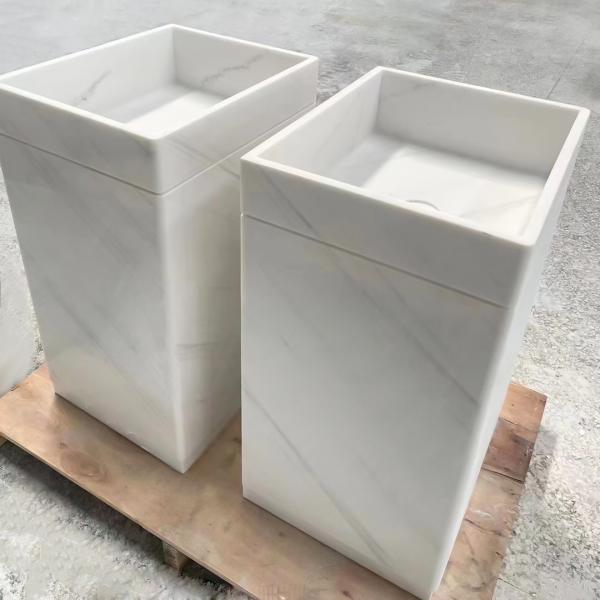
Solid Surface Sinks are an increasingly popular choice in modern kitchens and bathrooms. Popular for their seamless design, durability and ease of maintenance, they are molded into the countertop to not only enhance the aesthetics of the space, but also reduce sanitary dead ends. These sinks are suitable for a variety of environments, but proper cleaning and maintenance is essential to ensure their long-term effectiveness.

Routine Cleaning and Maintenance
Regular Cleaning Daily cleaning of Solid Surface Sinks is relatively simple. To ensure that the surface is free of dirt and spots, it is recommended to lightly clean it with warm water and a soft cloth every day or after each use. This will prevent the accumulation of water stains, soap residue or food stains.
Steps:
Moisten a soft cloth or sponge with warm water.
Add a small amount of mild detergent (e.g. neutral dishwashing liquid) and gently wipe the sink surface.
Rinse well with water and finish with a clean cloth to avoid water or mineral deposits.
Preventing Stain Buildup Although Solid Surface Sinks are resistant to stains, prolonged periods of time without cleaning may result in the formation of hard-to-remove stains on the surface. Prompt cleaning after each use is recommended, especially when working with foods rich in coloring or acids (e.g. coffee, red wine, fruit juices, etc.).
Use soft cleaning tools Avoid using hard cleaning tools such as metal brushes and steel wool balls when cleaning to avoid scratching the surface. Use soft sponges or microfiber cloths to effectively remove stains without damaging the surface.
Tackling stubborn stains and scratches
Removing Stubborn Stains For light, stubborn stains, use baking soda mixed with warm water. The slight abrasive action of the baking soda will effectively remove the residue.
Steps:
Make a baking soda paste by mixing baking soda with water in a 1:1 ratio.
Apply the paste to the stain and gently rub in circular motions with a soft cloth or sponge.
Rinse with water and dry with a dry cloth.
Treating minor scratches Another advantage of Solid Surface Materials is their repairability. If minor scratches appear on the surface of the sink, they can be repaired by sanding. Use fine sandpaper (e.g., 800 grit or better) to lightly sand the scratched area and buff it.
Step:
Lightly sand the scratched area with 800 grit or 1000 grit fine sandpaper, making sure to apply even pressure.
After sanding, rinse with water and dry before applying a polish to restore the shine.
Dealing with Deeper Scratches For deeper scratches or damage, a more specialized repair method may be required. You can start by sanding with coarser sandpaper and then gradually polish the repair with finer sandpaper. Call in a professional for sanding and polishing treatments if necessary.
Preventing Dirt and Damage
Avoid hot objects Although the solid surface material is heat resistant, placing hot objects (e.g. freshly boiled kettle, hot pots and pans, etc.) directly into the sink may result in localized damage or discoloration. It is recommended that a pot mat or stand be used to prevent the heat source from coming into direct contact with the sink surface.
Protection from chemicals Although solid surface materials are resistant to most household cleaners, prolonged exposure to strong acids, alkalis or chemicals containing corrosive ingredients (e.g. bleach, stain remover) should be avoided. These chemicals may cause discoloration or damage to the surface. In case of accidental contact, immediately rinse thoroughly with water.
Protect against heavy impacts Solid surface material is strong, but excessive impacts may cause cracks or damage to the surface. Avoid dropping heavy or sharp objects directly into the sink during use to prevent surface damage.
Regular maintenance
To keep your sink in top condition, regular deep cleaning and maintenance is recommended. You can use professional surface cleaners and polishes to give your sink an all-over cleaning and polishing treatment every once in a while.
Monthly deep cleaning: In addition to daily cleaning, the sink can be deep cleaned once a month using a baking soda paste or professional cleaner to remove hidden stains and grease.
Regular polishing: Polishing restores the glossy surface of your sink and also helps to repair minor scratches.
Restoration and refurbishment
Due to the repairable nature of the solid surface material, when the surface of the sink is badly scratched or worn, it can be refurbished through a professional sanding and polishing process to restore it to like-new condition. Here are some common suggestions for restoration:
Light Scratch Repair: By sanding with fine sandpaper, light scratches can repair themselves.
Professional refurbishment: For large areas of wear and tear or serious damage, it is recommended that professionals be called in for refurbishment treatment to ensure the best results.
Advantages of solid surface sinks
With proper cleaning and maintenance, solid surface sinks can retain their beauty and functionality for a long time. Solid surface sinks offer several significant advantages over traditional stainless steel or ceramic sinks:
1. Seamless design: Solid surface sinks are usually molded in one piece with the countertop, and the seamless design effectively prevents bacteria growth and dirt accumulation, making it easy to clean.
2. Strong durability: solid surface materials have excellent impact and stain resistance, suitable for a variety of domestic and commercial environments.
3. Highly repairable: Minor scratches and stains can be repaired with a simple sanding, keeping the sink in long-term use.
Solid Surface Sinks Solid Surface Sinks are ideal for modern kitchens and bathrooms because of their seamlessness, beauty, durability and ease of cleaning. With proper routine cleaning, preventative maintenance and regular servicing, you can ensure that these sinks retain their longevity and elegant appearance. In case of minor scratches or damage, they can also be restored to like-new condition by sanding and repairing them.